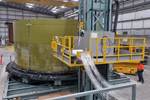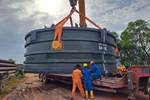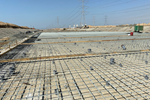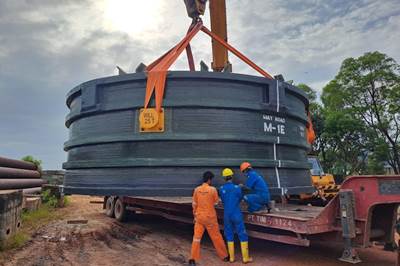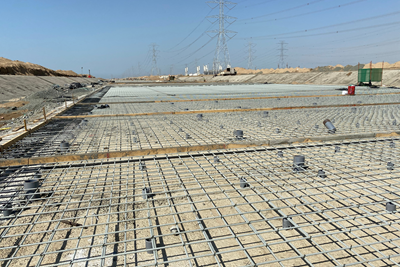Modular Brands uses LiteSIP composite structural insulation panels to speed construction of houses, roofs and commercial buildings. Source (All Images) | MDLR Brands
The U.S. is experiencing a housing crisis. Not only is there a massive shortage of homes, but prices are at all-time highs. Productivity in construction has actually been negative for about 50 years — U.S. construction companies are getting less efficient and delivering lower value. But composites can offer a solution. CW has written several articles about companies using composites in structural insulation panels (SIPs) for more efficient, affordable buildings (see “Fast-build construction with composites,” “Composites for builders” and “Thermoplastic composite panels deliver affordable housing”).
SIPs typically comprise a foam core — the most common being expanded and extruded polystyrene (EPS, XPS), polyurethane (PU) and polyisocyanurate (PIR) — sandwiched between facings of oriented strand board (OSB) made from shredded softwood and adhesive. Composite SIPs replace the OSB with lightweight sheets of fiber-reinforced polymer (FRP), typically using glass fiber and thermoset polyester or thermoplastics.
SIPs offer much faster construction — assembly in days versus weeks or months — with higher, more durable thermal insulation and strength up to seven times that of today’s timber frame houses. And yet they still make up only 1-2% of overall construction and only 8% of self-builds. Modular Brands (Chattanooga, Tenn., U.S.) is working to change that. “We are using composite SIPs to revolutionize construction,” says CEO Harrison Langley, “with affordable, efficient and sustainable buildings that meet housing and commercial needs.”
Real estate meets conservation
Langley’s vision grew from a background in real estate and a passion for conservation. For years, he worked with the International Waterkeeper Alliance in Collier County, Florida — an international network of more than 300 nonprofit groups fighting to protect everyone’s right to clean water. “I could see that the houses being sold could be built in a better way,” he says. “So, I began to research different technologies.”
Langley traveled to see Axia Materials’ thermoplastic composite panels in Korea (see linked article above), and also began working with Sulfibra (Iomerê, Santa Catarina, Brazil). “I’ve found several products to import, the majority using fiberglass composite skinned SIPs,” he explains. “They enabled our companies to build quickly, with lightweight, high-performance materials that offer a lot of benefits.” This includes PMRVs — park model recreational vehicles designed to provide temporary or seasonal housing — as well as tiny homes, auxiliary dwelling units (ADUs), modular homes and commercial buildings. Langley started MDLR Brands and Boxvana, a trademark of MDLR Brands, in 2018-19 to address these markets.
LiteSIPs, pultruded connectors
MDLR Brands manufactures lightweight composite SIPs for walls, floors and roofs and can also assemble these into prefabricated modules. Roof panels (top) typically weigh 1.1 pound/square foot (5.4 kilograms/square meter), facilitating handling and assembly.
The composite SIPs that MDLR Brands use are called LiteSIPs and are made with woven fiber-reinforced skins and foam core. “We can use a variety of materials,” says Langley. “It depends on the building’s requirements and what the client wants. We can use Sulfibra panels with fiberglass/polyester skins and PIR core, or we can use thermoplastic composite skins on a variety of cores. We typically use glass fiber, but we’ve also tried carbon fiber and hemp fiber — both work fine. We can also add other layers. For example, we can provide 20-year sun protection or add ceramic powder to the skin when a 1-hour fire rating is required.”
MDLR Brands also makes customized LiteSIP panels in-house using hand layup or an automated press system. “Typically, our panel size is 8-feet wide × 10-feet long,” says Langley, “but we can go up to 8 feet 10 inches × 40 feet, depending on the materials and panel construction required. We can also make panels in a variety of thicknesses. Our standard panel is 1.2 inches [30.5 millimeters] thick, but our ballistic-rated panels are 6.35 inches [161.3 millimeters and we can go up to 10 inches (254 millimeters)] thick.”
LiteSIPs can be connected using pultruded FRP beams and C-channels. “We’ve sourced these from Strongwell [Bristol, Va., U.S.] and Bedford Reinforced Plastics [Bedford, Pa., U.S.],” says Langley. “These have been used in applications like oil rigs for decades. They are a great product — strong and lightweight — and though they’re more expensive than steel and aluminum, the maintenance and long-term costs are much lower. We used them in a modular house we built in the Bahamas. It’s 2,800 square feet with four bedrooms, three baths and has one of our tiny homes as a guest house, which is 400 square feet with a 200-square-foot loft. Both are built completely with FRP beams and our LiteSIPs on top, rated for wind loads of 255 miles per hour.”
Meeting certifications
Langley explains there are typically four levels of regulations that buildings must comply with: city, county, state and federal. “Depending on where you are, all or some of them apply,” he notes. “We put one of our homes as a permanent ADU in Los Angeles and had to get city and county certifications, but in others, we’ve just applied to the county and had inspectors stamp the engineer drawings.” He adds that the approval process to build with composite SIPs is different depending on where you are in the U.S. “For example, if you’re starting in Florida, then it’s a real challenge and fairly expensive to complete all the testing required, but it also opens a huge market because many other states will accept those test results.
“We’ve received approval from Miami-Dade County in Florida for buildings that meet Category 5 hurricanes,” Langley continues. This includes testing with the global third-party certifier Intertek (London, U.K.). “We’re just finishing TAS 201, 202 and 203 testing with them, which are for structural roof and wall systems in Miami-Dade County.” TAS stands for “testing application standard,” which include wind, impact and uplift protocols required for high-velocity hurricane zone (HVHZ) buildings in Florida. But they’re also frequently approved for use elsewhere in the U.S. as an alternative standard to similar ASTM protocols. “If your products achieve that certification,” explains Langley, “then they can pretty much be used anywhere. But you also have IBC testing that’s often required at a federal level.” International building code (IBC) is used in all 50 U.S. states, as well as the District of Columbia, Guam, Northern Marianas Islands, New York City, the U.S. Virgin Islands and Puerto Rico.
MDLR Brands also had Intertek perform structural testing on its LiteSIP panels in 2017, to ASTM E72-15, Standard Test Methods for Conducting Strength Tests of Panels for Building Construction. This included testing of a 4 × 8-foot (3-square-meter), 100-millimeter-thick panel with EPS core and fire-retardant fiberglass skins under transverse load up to 335 pounds/square foot and under axial load and racking shear load to 5,921 and 14,767 pounds (2,696 and 6,698 kilograms), respectively. “The LiteSIP panels outperform standard timber framing in both transverse and racking shear loads,” says Langley, “offering higher structural strength and efficiency in a thinner profile.”
LiteSIPs have also passed numerous fire tests including ASTM E84. “Usually, the standard is to provide 30 minutes of fire resistance, but we can also make panels that pass 60-minute tests,” says Langley. “These tests are important when we work with government or commercial buildings. For example, we built surveillance rooms for the Hamilton County Sheriff’s Office [in Jasper, Florida] where we added on to an existing structure. And that was possible because we met the fire resistance and smoke toxicity tests required.”
Energy efficiency, durability
These successful test results and certifications are evidence of the high performance that can be achieved with LiteSIP construction. This includes energy efficiency. “We’ve passed Title 24 tests for energy efficiency on some of our units in California,” says Langley. “Effectively, this means you’re paying the minimum on your power bills because LiteSIPs maintain temperature so well, and there’s no thermal bridging.”
Thermal bridging is when heat bypasses insulation in a building, moving through more conductive materials like metal or wood studs. The result is energy loss, which increases heating and cooling bills, but also means energy is being wasted. This is exactly what Title 24, part of California’s Building Energy Efficiency Standards, aims to reduce, as it pursues a more resilient, affordable, equitable and sustainable energy system.
“With our panels, you have a completely controlled environment,” Langley continues. “That’s why these panels have been used in hospitals. You can also put a negative or positive pressure on them.” The latter are used in hospitals to prevent the spread of infectious contaminants. Negative pressure rooms use lower pressure to trap potentially harmful particles inside the room while positive pressure rooms maintain a higher pressure to keep possible contaminants out. These concepts are also used in industrial cleanrooms as well as by large agricultural growers, says Langley. “And these panels don’t mold or mildew like some construction materials, even when constantly exposed to moisture and cleaning solutions.”
This combination of long-term benefits is rare, notes Langley. “We not only maintain higher energy efficiency versus most construction types, but as an owner-operator, you will also have very low maintenance because you won’t have to deal with mold, mildew, rot or fire damage, nor corrosion with metal. Because of this, we have been talking with insurance companies to provide lower rates for buildings and even just roofs that use our LiteSIP panels.” We’ll come back to the roof market below.
Speed of construction, interior finishes
Langley says building with composite SIPs is much faster than stick-built construction. “You’re putting up a 20 × 8-foot wall [≈15 square meters] that weighs 160 pounds [73 kilograms] with just a crew of two to three builders. You don’t need a crane, and this size crew can frame an average-sized, one-story house in less than a week. We can reduce labor by up to 70% compared to wood framing.”
MDLR Brands shipped and assembled nine LiteSIP modules to construct this 2,800-square-foot house in 5 weeks.
He notes the modular home in the Bahamas took only 5 weeks from start to finish. “But that included transport to site.” Easy transport is another advantage. In this case, nine prefabricated modules were shipped by truck and then ferry to the site, where they were lifted into place by a small crane , assembled and finished. “Almost everything in the Bahamas has to be shipped in from somewhere,” notes Langley. “The alternative, using traditional framing, would have been really expensive and taken months. For us, the majority of the actual building process was finished in the first 10 days. The longest part was completing the interior finishes, but even that was much quicker than a standard build.”
MDLR Brands uses a variety of premade and custom in-house manufactured SIPs, bonding fiber-reinforced polymer (FRP) skins to insulating foam cores with an array of possible finish options, including exterior siding and drywall interiors.
For interiors, Langley says the most common choice is drywall, which is attached using furring strips — narrow wood strips screwed into the SIP, which the drywall sheets can then be screwed into. “And since the panels are so stiff, we can send them with the drywall already attached,” he adds. “We can also print the exterior and/or interior FRP skins with a pattern and then seal it. The result looks like wood or stone or tile. It’s a good surface that is easy to clean. Some clients just paint the panels after the installation is completed. We’ve seen a lot of different approaches.” For exteriors, houses are commonly clad with siding.
What about wiring and plumbing? “We can use conduit in the panels to run the wiring chases as well as vents or plumbing down from a second story,” says Langley. “We’ve also run wiring behind the drywall. Overall, it’s a really simple method of building. We pretty much build everything with two different sets of products — our composite SIPs and then connectors. Although we prefer to use the FRP connectors to prevent thermal bridging, we can use metal L-brackets as well.”
Cost, sustainability, future markets
MDLR Brands advertises its PIR foam-cored composite SIPs at $7.10, $7.70 and $8.30 per square foot for 4, 6 and 8 inches thick, respectively. Its ESP foam-core LiteSIPs range from $8.48 to $13.43 per square foot (2- to 10-inch thickness). Its Sedona compact modular building costs $18,500, comprising a 14 × 22-foot structure and 16 × 24-foot roof, while the Jupiter A-frame on a 20 × 20-foot pad costs $27,200.
MDLR Brands uses LiteSIPs to speed construction and lower cost for multiple markets, including roofs — shown at top for a house in the North Carolina mountains — and a range of small and tiny homes with high-quality finishes.
“Our material costs are a little more expensive than high-volume timber construction,” says Langley, “but we install much more quickly, and provide energy efficiency and durability benefits. We definitely compete with standard residential roofs.”
The price of wood is increasing because it’s becoming a harder resource to get, he adds. “There have been a lot of fires over the past couple of years, and the quality of the wood in number 1 or 2 lumber has decreased significantly. The material properties are lower, but the standard for construction is increasing — so, you need more and more wood just to meet the minimum standards. This is why you’re seeing more complex joists and ties that tend to be thicker and heavier.”
As a result, roofs have become a key market. “Our panels actually enable getting rid of truss systems, so that you can have vaulted ceilings,” says Langley. “Our 6-inch-thick SIP panels can span 16 inches instead of 12 inches, and they include insulation and three layers of protection already built-in — no further installation of glass wool or spray-foam is needed.” He notes this market is growing due to the increase in violent storms and resulting damage. “We can build back roofs more quickly and also stronger than before. That gives us an advantage in residential construction, and we can reduce total costs for commercial roofs by up to 30%. We are replacing five layers with one and connecting directly to the metal structure of those buildings.”
Langley sees composite SIPs as not only increasing energy efficiency, but sustainability overall. He notes that Sulfibra’s PIR foam core uses recycled PET bottles — reportedly 60 bottles in each meter of panel — and adds that his companies are also trying to reuse foam and panel scraps where possible. “And we’re also looking at more recycled and bio-based materials,” he notes. “We already meet current building standards, but we’re working to meet newer green building standards. What the construction industry is doing right now isn’t sustainable. We are proving that modularity with advanced materials is a solution, cutting waste and construction speed with less labor, and giving home and business owners more value and control of the building process. We’re expanding our modular home builds, with new projects in the Bahamas, as well as growth in Tennessee and Kentucky, while roofs are growing overall in the Southeast. We’re developing further automation and see potential for even larger growth in the future.”
Related Content
TU Munich develops cuboidal conformable tanks using carbon fiber composites for increased hydrogen storage
Flat tank enabling standard platform for BEV and FCEV uses thermoplastic and thermoset composites, overwrapped skeleton design in pursuit of 25% more H2 storage.
Read MoreRecycling end-of-life composite parts: New methods, markets
From infrastructure solutions to consumer products, Polish recycler Anmet and Netherlands-based researchers are developing new methods for repurposing wind turbine blades and other composite parts.
Read MorePEEK vs. PEKK vs. PAEK and continuous compression molding
Suppliers of thermoplastics and carbon fiber chime in regarding PEEK vs. PEKK, and now PAEK, as well as in-situ consolidation — the supply chain for thermoplastic tape composites continues to evolve.
Read MoreInfinite Composites: Type V tanks for space, hydrogen, automotive and more
After a decade of proving its linerless, weight-saving composite tanks with NASA and more than 30 aerospace companies, this CryoSphere pioneer is scaling for growth in commercial space and sustainable transportation on Earth.
Read MoreRead Next
Composites enable massive wastewater infrastructure project
To build complex drop shafts for New Zealand’s Central Interceptor project, RPC Technologies pushed the limits with glass and carbon fiber, vertical filament winding and UV-cure resins.
Read MoreComposites end markets: Infrastructure and construction (2024)
Composites are increasingly used in applications like building facades, bridges, utility poles, wastewater treatment pipes, repair solutions and more.
Read MoreComposite rebar for future infrastructure
GFRP eliminates risk of corrosion and increases durability fourfold for reinforced concrete that meets future demands as traffic, urbanization and extreme weather increase.
Read More


